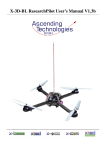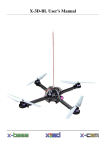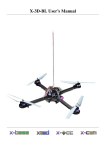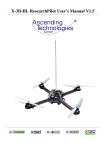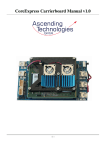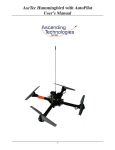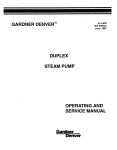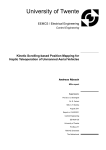Download asctec X-3D-BL User`s manual
Transcript
X-3D-BL Scientific User’s Manual
X-3D-BL Scientific User’s Manual
Inhaltsverzeichnis
1 Introduction
1.1 System overview . . . . . . . . . . . . . . .
1.1.1 X-CSM . . . . . . . . . . . . . . . .
1.1.2 X-Base . . . . . . . . . . . . . . . .
1.1.3 X-3D . . . . . . . . . . . . . . . . .
1.1.4 Motors . . . . . . . . . . . . . . . .
1.1.5 X-BLDC brushless motor controllers
1.1.6 X-ACC . . . . . . . . . . . . . . . .
1.2 Transmitter . . . . . . . . . . . . . . . . . .
.
.
.
.
.
.
.
.
4
4
4
4
6
6
6
6
7
2 Things to do before the first flight
2.1 Mounting the propellers . . . . . . . . . . . . . . . . . . . . . . . . . . . . . . . . . . . . .
2.2 Preparing your own battery . . . . . . . . . . . . . . . . . . . . . . . . . . . . . . . . . . .
2.3 Teach-in of your transmitter . . . . . . . . . . . . . . . . . . . . . . . . . . . . . . . . . .
8
8
8
9
3 Operating the X-3D-BL Scientific
3.1 Important things to keep in mind . . . . . . . . . . . . . . . . . . . . . . . . . . . . . . . .
3.2 First flight . . . . . . . . . . . . . . . . . . . . . . . . . . . . . . . . . . . . . . . . . . . .
10
10
10
4 On-Board serial interface
4.1 Physical interface . . . . . . . . . . . . .
4.2 Data protocol . . . . . . . . . . . . . . .
4.2.1 Data output . . . . . . . . . . . .
4.2.2 Command input . . . . . . . . . .
4.3 Test software . . . . . . . . . . . . . . .
4.4 General hints for using the serial interface
.
.
.
.
.
.
12
12
12
12
13
14
14
.
.
.
.
.
15
15
15
16
16
17
.
.
.
.
.
.
.
.
.
.
.
.
.
.
.
.
.
.
.
.
.
.
.
.
.
.
.
.
.
.
.
.
.
.
.
.
.
.
.
.
.
.
.
.
.
.
.
.
.
.
.
.
.
.
.
.
.
.
.
.
.
.
.
.
.
.
.
.
.
.
.
.
.
.
.
.
.
.
.
.
.
.
.
.
.
.
.
.
.
.
.
.
.
.
.
.
5 Software updates and system configuration changes
5.1 Software update of the X-3D . . . . . . . . . . . . . . .
5.2 Software update of the X-Base . . . . . . . . . . . . . .
5.3 Setting up the X-BLDC brushless motor controllers . . .
5.4 X-3D Parameters . . . . . . . . . . . . . . . . . . . . .
5.5 Calibration of the acceleration sensors . . . . . . . . . .
.
.
.
.
.
.
.
.
.
.
.
.
.
.
.
.
.
.
.
.
.
.
.
.
.
.
.
.
.
.
.
.
.
.
.
.
.
.
.
.
.
.
.
.
.
.
.
.
.
.
.
.
.
.
.
.
.
.
.
.
.
.
.
.
.
.
.
.
.
.
.
.
.
.
.
.
.
.
.
.
.
.
.
.
.
.
.
.
.
.
.
.
.
.
.
.
.
.
.
.
.
.
.
.
.
.
.
.
.
.
.
.
.
.
.
.
.
.
.
.
.
.
.
.
.
.
.
.
.
.
.
.
.
.
.
.
.
.
.
.
.
.
.
.
.
.
.
.
.
.
.
.
.
.
.
.
.
.
.
.
.
.
.
.
.
.
.
.
.
.
.
.
.
.
.
.
.
.
.
.
.
.
.
.
.
.
.
.
.
.
.
.
.
.
.
.
.
.
.
.
.
.
.
.
.
.
.
.
.
.
.
.
.
.
.
.
.
.
.
.
.
.
.
.
.
.
.
.
.
.
.
.
.
.
.
.
.
.
.
.
.
.
.
.
.
.
.
.
.
.
.
.
.
.
.
.
.
.
.
.
.
.
.
.
.
.
.
.
.
.
.
.
.
.
.
.
.
.
.
.
.
.
.
.
.
.
.
.
.
.
.
.
.
.
.
.
.
.
.
.
.
.
.
.
.
.
.
.
.
.
.
.
.
.
.
.
.
.
.
.
.
.
.
.
.
.
.
.
.
.
.
.
.
.
.
.
.
.
.
.
.
.
6 Contact Information
18
A Troubleshooting
A.1 Slight tilt in pitch/roll with the pitch/roll stick in neutral position . . . . . . . . . . . . . . .
A.2 Considerable tilt in pitch or roll . . . . . . . . . . . . . . . . . . . . . . . . . . . . . . . . .
A.3 Bad reception during flight . . . . . . . . . . . . . . . . . . . . . . . . . . . . . . . . . . .
19
19
19
19
Ascending Technologies GmbH
-2-
www.asctec.de
X-3D-BL Scientific User’s Manual
A.4 The red LED on the X-3D keeps blinking after the startup . . . . . . . . . . . . . . . . . . .
A.5 The X-3D-BL turns itself off during flight . . . . . . . . . . . . . . . . . . . . . . . . . . .
B User-programmable startup melodies
Ascending Technologies GmbH
20
20
21
-3-
www.asctec.de
X-3D-BL Scientific User’s Manual
1 Introduction
Thank you for purchasing the X-3D-BL Scientific.
Please read this manual carefully before you start to
work with your new vehicle.
WARNING!
A motorized model aircraft is not a toy! It should only
be flown by adults. Improper assembly or operating
can lead to severe injuries and / or damages. Trouble
with your remote control due to interferences can
occur any time without prior notice. Sometimes, a
model aircraft can suddenly become uncontrollable due to a failure of any component, including
mechanical parts and electronics. In this case, the
model can rapidly move towards any direction. Make
sure you always keep a safe distance to people,
animals, obstacles or things of any kind, traffic roads,
etc.. There are country-specific laws regulating the
operation of model aircrafts that definitely have to
be obeyed. Furthermore, we strongly recommend to
effect a liability insurance for model aircrafts. The
manufacturer and your dealer of the X-3D-BL do
not have any influence on, nor can they monitor the
correct assembly and proper operation of your model
aircraft. Always be aware of the dangers mentioned
above and act accordingly. There is no liability of the
manufacturer nor the retailer at all, as far as legally
approved.
1.1 System overview
In this section you find some information about the
subsystems used in the X-3D-BL Scientific. These
components are also used in the hobbyist version of
the X-3D-BL, however, the X-3D-BL Scientific onboard software is different.
1.1.1 X-CSM
The X-CSM is the mechanical frame of the X-3DBL UFO. The booms, which are made of a rigid
carbon fiber-balsa wood sandwich material, can be
replaced individually. The central unit of the frame
called the ”X-CSM Core” is made of light weight
laser-cut magnesium parts. Being built out of these
state-of-the-art materials the X-CSM is a very robust
high-tech basis for your quadrotor aircraft.
Our products are designed for the civil market only.
It is strictly forbidden to use them in any military environment or to retail them to any military or military
related organization. Using any of our components for
1.1.2 X-Base
larger scale flying objects is also not allowed.
SUBJECT TO CHANGE WITHOUT NOTICE.
Ascending Technologies GmbH
The X-Base is the central control unit which is
connected to and communicates with all active
elements of the X-3D-BL. Next to the battery, the
motor controllers, the X-3D gyro and the receiver
-4-
www.asctec.de
X-3D-BL Scientific User’s Manual
you can also connect several LEDs to the X-Base to
give your X-3D-BL a unique fancy look.
1 BL-controllers / brushed motors (+)
2 BL-controllers (-)
3 Brushed motors (-) Left/Right/Back/Front
4 PPM-Receiver Input (-) (+) Signal
(from lower to upper connector)
5 LEDs (-) Left/Right/Rear/Front
6 LEDs (+) 5V
7 Power connector, (+) and (-) marked on the
upper side of the board
The key below the power connector (7) turns the
X-3D-BL on and off. A short press is enough to turn
the vehicle on. To turn it off the key has to be pressed
for at least 200ms.
The ”brushed motors” connectors of the X-Base (3)
are not required as the brushless motors are driven by
independent controllers, and thus the connectors can
be used to drive peripherals like for instance a nightflight kit. Connector ”L” is switched on and off by
R/C channel 5, connector ”R” by R/C channel 6. The
connectors can sink currents up to 5A if they’re enabled. That means that the (-)-input of a peripheral has
to be connected to the ”L” or ”R” pad and the (+)input has to be connected to (+) (connector (1)). Be
aware that in this configuration your peripheral will
be supplied the whole battery voltage. If this not what
An LED connected to the ”Front-LED” Pads on the you need make sure you use a suitable voltage regubottom side of the X-Base will always be on as long lator.
as the X-3D-BL is turned on. Such an LED can be
mounted to the very front of your vehicle to make it
easier for the pilot to know where the front side is.
Ascending Technologies GmbH
-5-
www.asctec.de
X-3D-BL Scientific User’s Manual
1.1.3 X-3D
1.1.5 X-BLDC brushless motor
controllers
The X-3D is the sensor unit of the X-3D-BL. With
three piezo-gyros and highly optimized control
loops it does the actual flight/attitude control. All
parameters influencing the in-flight behavior can be
tuned by connecting the X-3D to a PC using the USB
adapter that came with your X-3D-BL. Once you are
on the field for flying you can select four different
parameter sets using two jumpers.
Every motor is controlled by an independent XBLDC brushless motor controller. The controllers are
highly optimized for the X-BL-52s motors and thus
ensure the highest efficiency possible. Please note that
for this reason the controllers might not work with a
different motor type.
1.1.6 X-ACC
The X-ACC is a tiny add-on module comprising a
triaxial accelerometer.
LED patterns shown by the X-3D
• red blinking: Initializing or at least one motor
not detected
• yellow+green: No reception or playing startupmelody
• green: Ready to fly
Using the acceleration data the X-3D can compute the
absolute orientation of the vehicle in pitch and roll.
The datafusion is done with an update rate of 1kHz to
The X-BL-52s motors by HACKER Motors Germa- guarantee good stability. As a consequence, the heliny are custom-built for the X-3D-BL. The motors are copter is able to come back to a horizontal orientation
perfectly suited for the application in this vehicle.
on its own. In the X-ACC mode the pilot - or your own
add-on electronics - command an absolute angle. The
further you push the pitch or roll stick, the bigger the
tilt-angle of the X-3D-BL. If you leave the stick centered the helicopter will come back to horizontal. In
this mode you are not able to do loops or flips, however, hovering and all 2D-maneuvers are much easier
to do. The X-ACC is also a great help for beginners!
In addition, the vehicle can be position stabilized by
a simple PD-Loop.
1.1.4 Motors
Ascending Technologies GmbH
-6-
www.asctec.de
X-3D-BL Scientific User’s Manual
1.2 Transmitter
Any five or more channels R/C transmitter can be
used to operate the X-3D-BL scientific. Even if it
is controlled autonomously by your own controller
board, the transmitter is required as a backup. As a
safety measure the X-3D-BL scientific is not able to
launch without a valid signal from the R/C transmitter.
Ascending Technologies GmbH
-7-
www.asctec.de
X-3D-BL Scientific User’s Manual
2 Things to do before the first flight
The X-3D-BL is shipped completely assembled and
tested. You only have to do the following steps to make it work with in combination with your equipment.
2.1 Mounting the propellers
To improve the durability of the propellers during a
The propellers can be slid over the axles and be faste- crash you can optionally add a cable tie (e.g. 2.5 x
ned using a plastic nut. Do not fasten the nut too tight, 100 mm) as seen in the following picture.
as this would bend the propellers.
Please note that there are two types of propellers: One 2.2 Preparing your own
pair of propellers is spinning clockwise, the other pair
battery
is spinning counterclockwise. The propellers spinning clockwise must be mounted to the front and
the rear motor, whereas the counterclockwise rotating You need a 3s (three cells, 11.1V) Lithium Polymer
propellers must be mounted to the left and to the right (LiPo) Battery. We recommend capacities between
motor.
1500 and 2100 mAh. With a state-of-the-art 2100
Ascending Technologies GmbH
-8-
www.asctec.de
X-3D-BL Scientific User’s Manual
mAh battery the vehicle is able to hover up to 23 mi- by the software.
nutes without any payload, and up to 12 minutes with
You can freely choose a stick on your R/C for eve200 g of payload.
ry function. If you are used to a certain configuration
Make sure you mount your battery such that it can you should definitely continue using this one. If you
definitely not get damaged by hitting the frame, even haven’t flown other model aircrafts before we recomin a crash. Otherwise the battery could explode! Here mend the following configuration (”Mode 2”):
is an example of how to mount a battery correctly:
The black foam on both sides hinders it from being
hurt by the magnesium parts of the frame. The
woodden plate on the bottom makes it stick to the
screw holding the bottom plate of the frame. Of
course, there are many different ways to prepare your
battery for a safe operation. This is only an example.
The X-3D-BL scientific works with any R/C with at
least five channels. Make sure that all channels work
Lithium Polymer Batteries (LiPo) can be very independently and that no mixers are active in your
dangerous if not handled correctly. Please read and remote.
follow the instructions of the battery and charger
manufacturers! Do never short circuit a LiPo battery Please make sure you assign a switch on your R/C
transmitter to the SW1-function, as you will need this
and use safe connectors!
channel to activete the serial interface onboard your
X-3D-BL Scientific.
2.3 Teach-in of your
transmitter
If you want to use your own transmitter which
you did not purchase bundled with the X-3D-BL
Scientific, please follow these steps:
First of all, you need to install the X-Control PCSoftware. If you didn’t receive a copy of it please contact us by e-mail. Connect the USB adapter to your
PC and to the X-Base, turn on your UFO, open the XControl software and click on ”X-Base” and then on
”Connect”. Then choose ”Receiver setup” and ”Automatic calibration”and follow the instructions given
Ascending Technologies GmbH
-9-
www.asctec.de
X-3D-BL Scientific User’s Manual
3 Operating the X-3D-BL Scientific
3.1 Important things to keep in
mind
• There is a battery warning implemented in your
X-3D-BL. A low battery is signalized by a periodic, simultaneous tremor of all motors. This
is hard to see but it can be heard. Depending on
the battery you use there is about a minute of
flight time left after the low-battery warning is
activated. Lithium Polymer (LiPo) batteries are
very vulnerable to deep discharge. That is why
the X-3D-BL turns off completely if the voltage drops under a programmable threshold. You
can adjust the thresholds for the low-battery warning and the low-battery shut down using the XControl software. Therefor you have to connect
the X-Base to your PC using the USB adapter
and click on ”X-Base”, ”Connect” and then on
”Parameters”.
• Directly after turning the X-3D-BL on the motors produce a short beep. It is perfectly normal
that the propellers move slightly during that tone.
• Keep the X-3D-BL totally still after turning it
on until the X-3D shows the yellow+green (no
reception) or green (ready to fly) light pattern.
Otherwise the sensors can not be calibrated correctly and the vehicle might go crazy after turning on the motors. If you accidentally moved
the system during startup simply turn it off and
on again.
• If the ambient temperature changes rapidly, for
instance when you leave a warm room, the
angles estimated by the datafusion algorithms
might not be totally correct. As a consequence
your vehicle would be tilted a bit, even with a
neutral pitch and roll command. In this case we
recommend to wait a few minutes, until all sensors have adopted to the ambient temperature.
• If only the green LED at the X-3D board is on
the vehicle is ready to fly. A yellow+green light
pattern means ”no reception”. In this case please check that your remote control is turned on
and fully functional, that the receiver crystal is
installed in the receiver and that the receiver is
connected correctly.
• After the startup phase the motors are still turned off and secured. To turn them on you have to
move the yaw stick to the very left or to the very
right while your throttle stick is in zero position.
The motors will then start and keep running at
their minimum speed. To turn the motors off you
have to do the same procedure again: Move the
yaw stick to the very left or to the very right while your throttle stick is in zero position. There
is no flight maneuver where one would use this
control input and thus you will not accidentally
turn off your motors during flight. For safety reasons you should turn off the motors immediately
if one of the propellers touches the ground or any
other obstacle and hence the X-3D-BL Scientific
is not able to take off.
Ascending Technologies GmbH
3.2 First flight
We recommend to do the first flights on some big
grassland, as the soft ground will soften possible
crashes. If you have never controlled an R/C aircraft
before you will have to practice a bit until you’re able
to fly inside your lab.
Make sure that the battery is fully charged, connected
and mounted correctly. Switch on the vehicle and be
really careful during the startup phase. The vehicle
must NOT be moved during startup as the gyro
sensors are being initialized! If the vehicle was
moved during startup simply turn it off and on again.
- 10 -
www.asctec.de
X-3D-BL Scientific User’s Manual
The startup sequence is completed once the motors land on tables etc.. Good luck!
start playing the preprogrammed music. Please be
aware, that the first ”beep” after turning the vehicle
on is part of the startup process. Once the music has
been played the X-3D will light the green and yellow
LEDs if the transmitter is turned off and only green
if a valid signal is detected. Now the vehicle is ready
to fly.
To start the motors you have to move the left stick to
the very left or right whilst holding throttle in zero
position.
If it is the first flight after a while or the first flight at
all hold your X-3D-BL Scientific down to the floor.
You can grab the center part of the frame, but make
sure that you don’t touch any of the rotors.
In case it tries to tilt in any direction and one or more
of the propellers are going crazy: Please read the
troubleshooting section of this manual.
Angle stabilization in pitch and roll is active even
when the propellers are running idle. Use this feature as you hold the vehicle from below and tilt it
carefully to check that everything works. As you tilt
it to one direction you must feel some counterforce
from the motors if everything is o.k.. You can also try
to steer the pitch and roll axis and see that you can
directly steer the angles. Please check if the vehicle
is leveled in your hand with the pitch and roll stick
in neutral position. If not, correct any undesired tilt
with the pitch and roll trimmers.
Now, give a little throttle and the vehicle should hover. Try hovering in a height of about 1m and concentrate on the red marking which is the front of your
vehicle. Try to compensate for any movement in yaw
by moving the yaw-stick in the opposite direction. It
is much easier to control the vehicle if red is facing
away from you, as in this case it will move away from
you if you push your pitch/roll stick away. It is perfectly normal that the vehicle drifts slowly in all directions. As long as you have not installed any external
tracking for position control, you have to compensate for these movements manually. After a few battery
charges you will able to fly in any room, and with some more practice you can even fly in small spaces and
Ascending Technologies GmbH
- 11 -
www.asctec.de
X-3D-BL Scientific User’s Manual
4 On-Board serial interface
4.1 Physical interface
4.2.1 Data output
The interface is a serial uart link with 5V TTL levels at 38400 baud, 8 bits, one startbit, one stopbit.
To connect a PC, a bluetooth link or a high level processor to the X-3D you can use the black DF3 3-pin
connector.
The X-3D sends the following data packet with an
update rate of 100Hz whenever the RTS pin is low
(either forced always low by a jumper or pulled low
by e.g. a bluetooth module whenever it is ready to
send).
The data packet sent starts with two startbytes and
ends with two stopbytes:
startbyte 1: ’P’
startbyte 2: ’I’
You can set a jumper to permanently enable the data stopbyte 1: ’E’
output.
stopbyte 2: ’Z’
Pin 1 (the inner pin)
Pin 2
Pin 3 (the outer pin)
GND
RXD (input)
TXD (output)
In between these characters the following structure is
sent:
Alternatively, you can use the pin as an input for
a radio modem’s RTS (Request To Send) pin. The
X-3D-BL Scientific will only send data if the RTS
pin is pulled low by the connected device. It will stop
sending data if the Pin is pulled high by the modem
to prevent data loss during the transmission.
4.2 Data protocol
Ascending Technologies GmbH
struct DATA
{
unsigned char ident;
short angvel_pitch;
short angvel_roll;
short angvel_yaw;
short acc_x;
short acc_y;
short acc_z;
long angle_pitch;
long angle_roll;
unsigned char pitch;
unsigned char roll;
unsigned char thrust;
unsigned char yaw;
unsigned char voltage;
unsigned char command_status;
unsigned short timeStamp;
unsigned char chkSum;
};
- 12 -
www.asctec.de
X-3D-BL Scientific User’s Manual
Explanation of the data packet:
of 10Hz to 20Hz over the serial link:
• ident: Packet identifier; must always be ’d’.
•
•
•
•
startbyte 1: ’U’
startbyte 2: ’F’
angvel pitch, angvel roll, angvel yaw:
startbyte 3: ’O’
Angular velocities.
Range: 0..1023, 512 = neutral, 1 LSB = 0.304 no stopbyte!
deg/s
struct COMMANDDATA
acc x, acc y, acc y: Accelerations in 1/1000th g, {
with g being the acceleration of gravity.
unsigned char ident;
unsigned char channels[4];
angle pitch, angle roll: Angle estimates in pitch
unsigned char channel_select;
and roll in 1/10th of a degree.
unsigned char chkSum;
pitch, roll, yaw, thrust: Commands received };
from the R/C transmitter.
• voltage: Battery voltage in 0.1V
• command status:
bit 0: pitch, bit 1: roll, bit 2: yaw, bit 3: thrust
If a bit is set (1) the associated channel is controlled by the serial interface, otherwise (bit=0)
by the R/C transmitter.
bit 4:
1 → command interface enabled by a switch on
your R/C transmitter
0 → command interface disabled
bit 5:
1 → channel 6 > 0
0 → channel 6 < 0
bit 6:
1 → cmd packet received during the last 250ms
0 → no cmd packet received during the last
250ms
bits 7: reserved.
Explanation of the command packet:
• timeStamp: 16 bit counter, incremented with
every data packet.
• ident: Packet identifier; must always be ’C’.
• channels[4]: Control inputs for the
individual channels.
channel[0]: pitch axis
channel[1]: roll axis
channel[3]: yaw axis
possible values: 0..255, neutral = 127
channel[2]: thrust, 0(min)..255(max)
• channel select: Control-byte to determine which
channel is controlled by the R/C transmitter, and
which one is controlled by the serial interface.
bit 0: pitch, bit 1: roll, bit 2: thrust, bit 3: yaw,
bits 4..7: reserved.
If a bit is set (1) the associated channel is controlled by the serial interface, otherwise (bit=0)
by the R/C transmitter. Default is 0x00.
• chkSum:
(pitch+roll+yaw+thrust+channel select)
0x100
• chkSum = SUM(ident..timeStamp) % 0x100
%
4.2.2 Command input
As a safety precaution the vehicle will switch back to
the transmitter and thus manual control after 100ms
With the command protocol a single or all control not receiving data from the serial link.
channels can be taken over by the serial interface.
Therefore the X-3D-BL Scientific must receive the
following command data packet with an update rate
Ascending Technologies GmbH
- 13 -
www.asctec.de
X-3D-BL Scientific User’s Manual
4.3 Test software
There is a graphical user interface (X-3DBL Scientific Testsoftware.exe) to visualize the
data packets described above. You can use this
program to better understand the serial interface and
to check if everything is working correctly.
If you did not receive a copy of this software please
contact us by e-mail.
4.4 General hints for using the
serial interface
To enable the command interface, the vehicle must
have a stable link to a normal RC transmitter (green
light on the X-3D!) and the SW1 function (see ”Receiver Setup” in the X-Control software with the XBase connected) must be >128 to activate the commands from the interface. This is a safety function
as well. A skilled pilot should always be ready to take
over by setting the SW1 function back to 0 (e.g. with a
switch) to take control, if your high level control is not
functioning as desired. The pilot also has to steer all
functions that are not activated in the channel select
byte. Consequently you can activate one function after another, which makes setting up and tuning highlevel control loops much easier.
Ascending Technologies GmbH
- 14 -
www.asctec.de
X-3D-BL Scientific User’s Manual
5 Software updates and system configuration changes
The X-3D-BL is shipped with a fully functional
firmware installed on all components. Please do not
upload any code from our public servers, as these
versions do not offer the additional features of your
X-3D-BL Scientific. You only need to do a software
update if you receive a new version from us.
To perform a software update you need the X-Control
PC-software. If you did not receive a copy of it, please
contact us via e-mail.
Choose the serial port (normally ”Autoselect:
COMxx”) and click on ”connect”. Click on ”select
firmware” and select the firmware file ”*.ufc” you
received from us. Then click on ”Upload”, wait for
the upload to be completed, disconnect the USB adapter from the X-3D, remove the bootloader jumper
and click on ”Finished”. The X-3D software update
is now completed.
5.1 Software update of the
X-3D
Disconnect the battery from the X-3D-BL. You need
a jumper to activate the so called bootloader. Set the
jumper to the following position:
5.2 Software update of the
X-Base
Again, you need a jumper to activate the so called
bootloader. Set the jumper as seen in the following
picture.
Connect the USB-adapter to your computer. Open
the X-Control software, click on ”X-3D” and on the
left hand side on ” X3D firmware upgrade”. Then,
connect the X-3D to the USB adapter as seen in the
following picture.
Ascending Technologies GmbH
- 15 -
www.asctec.de
X-3D-BL Scientific User’s Manual
Open the X-Control software, click on ”X-Base” and
then on ”X-Base firmware Upgrade” on the left hand
side. Turn on the X-Base (In this case the battery has
to be connected to the vehicle!) and connect the USB
adapter to the X-Base.
Open the X-Control software and click on ”X-Base”.
Choose the correct COM-Port (normally ”Autoselect:
COMxx”) and click on ”Connect”. Chose ”X-BL
Setup” and click on ”start search”. After several
seconds four brushless controllers with different
serial numbers should appear in the list. If less than
Choose the serial port (normally ”Autoselect: four controllers appear, turn of your X-3D-BL, check
COMxx”) and click on ”connect”. Select the ”* all solderings and connectors and repeat the previous
ACT receiver.xbs” firmware file if you are using an steps.
ACT receiver (35 or 40 MHz) or select the ”* PPM
receiver.xbs” if you are using a different receiver.
Then click on ”Upload”, wait for the upload to be If all four controllers have been found, click on
completed, disconnect the USB adapter from the ”config” and follow the instructions given by the
X-Base, remove the bootloader jumper and click software in order to tell each controller its own
on ”Finished”. The X-Base software update is now position and the appropriate turning direction. After
that, click on ”Disconnect” to complete the controller
completed.
setup.
5.3 Setting up the X-BLDC
brushless motor
controllers
Optionally a startup melody can be installed using the
X-BL update function. A detailed description of how
to do this can be found in appendix B.
5.4 X-3D Parameters
The X-Base will not recognize all motors before they
have been set up correctly. This is absolutely normal!
Not until a successful configuration the X-Base will If you connect the X-3D to the X-Control software
recognize all X-BLDC controllers and the X-3D-BL without the bootloader jumper set, you can change all
parameters influencing the system behaviour. You can
UFO will signal ”ready to fly”.
also save a set of parameters to port it to a second
vehicle, or you can upload a set of parameters which
Connect the battery to the X-3D-BL, turn it on and you received from us.
connect the USB adapter with your computer and
then with the X-Base.
Ascending Technologies GmbH
- 16 -
www.asctec.de
X-3D-BL Scientific User’s Manual
5.5 Calibration of the
acceleration sensors
The X-3D-BL Scientific comes fully calibrated. However, if something goes really wrong and for some
reason you need to recalibrate the accelerometers,
here is what you have to do.
Connect the X-Base with the X-Control software,
open the X-ACC setup and follow the instructions
given by the wizard. To achieve the best performance
it is very important that the calibration is done very
precise. Please check that after the calibration the
X- and Y-outputs are roughly zero and the Z-output
is roughly -1000 if the X-3D-BL is standing in a
horizontal orientation. The automatic calibration
gives usable results, but sometimes the values can
still be optimized manually. Please also check the
scale factors, i.e. see, if all sensor outputs are about
±1000 if you hold the vehicle with the respective
axis in a vertical orientation. If everything seems
o.k. you can finalize the calibration by clicking on
”Finished” and on ”Transmit and disconnect”.
Ascending Technologies GmbH
- 17 -
www.asctec.de
X-3D-BL Scientific User’s Manual
6 Contact Information
Ascending Technologies GmbH
Graspergerstr. 8
82131 Stockdorf
GERMANY
Phone: +49 89 89949847
E-Mail: [email protected]
Web: www.asctec.de
CEOs:
Michael Achtelik, Klaus-Michael Doth
Dipl.-Ing. Daniel Gurdan, Dipl.-Ing. Jan Stumpf
Handelsregister München: HRB 166748
Ust.-ID: DE254728199
Ascending Technologies GmbH
- 18 -
www.asctec.de
X-3D-BL Scientific User’s Manual
A Troubleshooting
This chapter holds solutions to problems which might
occur during the operation of your X-3D-BL UFO.
A.1 Slight tilt in pitch/roll with
the pitch/roll stick in
neutral position
Due to unavoidable measurement errors it is perfectly
normal, that your X-3D-BL is not always flying
exactly leveled in the X-ACC mode. However, a
slight tilt can easily be compensated by the trimmers
on your remote control.
A.2 Considerable tilt in pitch
or roll
There are some situations where the measured angle
can considerably differ from the real angle, which results in big tilt-angles in pitch and/or roll while the
pitch/roll stick on your remote is centered. This can
have the following reasons:
USB adapter and open the X-Control software to
check if all channels are detected as centered if
the sticks on the R/C are centered. If this is not
the case repeat the teach-in of your R/C following the instructions given by the software.
• Faulty calibration of the accelerometers: If after restarting the X-3D-BL the unwanted tilt is
still there and cannot be compensated using the
trimmers on your remote, please check the calibration of your X-ACC (cf. 5.5).
• Rapid change of the ambient temperature: If you
notice a considerable tilt in pitch or roll directly after you leave a warm room in winter or an
air-conditioned room in summer, please wait a
few minutes, until all sensors have adopted to the
new ambient temperature. Alternatively, you can
use the Heading-Hold mode during that period,
as this mode behaves much more robust during
fast temperature changes.
• Extremely fast maneuvers: Also fast maneuvers,
which result in high accelerations interacting
with your aircraft, can cause faulty measurements. If you fly several circles in a row in high
speeds it can happen, that the measured angle
differs several degrees from the real angle. If this
is the case, you simply have to fly gently or hover for a few seconds until the unwanted tilt is
gone.
• Shaking during initialization: In the X-ACC mode it is particularly important that the vehicle is
not moved at all during the initialization. Calibration errors caused by shaking during startup
will influence the performance much more than
in the heading-hold mode. If the vehicle tilts mo- A.3 Bad reception during flight
re and more after starting the motors it is very
likely that it was moved during the initialization.
If the X-3D-BL does not react while it is airborne,
In this case, please turn it off and on again and
please check if someone else uses the same channel.
make sure that it is not moved until the X-3D
Make sure your TX battery is fully charged and that
displays the green+yellow or green light pattern.
the antenna is fully extended. If you are still having
• Teach-in of your transmitter was not correct: To trouble you can to the following test to check the
check if your transmitter was taught-in correctly, range of your R/C system:
please connect the X-Base to your PC using the
Ascending Technologies GmbH
- 19 -
www.asctec.de
X-3D-BL Scientific User’s Manual
During the range check all other transmitters should
be switched off. The best location to do the test is a
big open field, as metallic objects like cars or wire
fences could influence the result. You need a helper
who holds your transmitter with the antenna as close
to vertical as possible. Turn the X-3D-BL on and wait
until only the green LED on the X-3D is on signalizing ”ready to fly”. Then walk away from the transmitter until the yellow LED starts flickering. At this
point you should be at least 100 m away from your
TX. Repeat the whole procedure with the motors running at minimum throttle. If at a distance of about 100
m the signal is still o.k. (i.e. only the green is LED
on), your reception is totally fine. Due to the size of
the aircraft and the associated visibility you will never fly any further away than that. If the yellow LED
comes up randomly at shorter distances your TX/RX
combination is to weak. In this case you can try extending the antenna of the X-3D-BL by using a longer
plastic tube or stick which holds the antenna. A fully extended antenna works definitely better than one
which is wound around a stick as described in this manual. If you use a stub antenna at your TX this could
also be the reason for a bad reception, as such antennas do not transmit the full power. In this case try
using a standard telescopic antenna instead.
connect the X-Base to the X-Control software it will
show you which of the motors is not working correctly.
A.5 The X-3D-BL turns itself
off during flight
Please make sure that the current limit of your X-Base
is set to 35 A. To do so, please connect the X-Base
to the X-Control software and click on ”parameters”.
The value of the edit-field designated with ”Current:”
must be 35. Once you are done click on ”Finished”
and then on ”Transmit and disconnect”.
A.4 The red LED on the X-3D
keeps blinking after the
startup
If you have not configured your X-3D-BL using the
X-Control software as described above this behavior
is normal. In this case please follow the instructions
given in ??. If the configuration of your vehicle was
completed successfully the blinking red LED means
that one of the motor controllers or motors was not
detected. Please check if all four cables in black and
blue color between the X-Base and the motor controllers are connected correctly. If all connections are o.k.
please verify that all motors produce a short beep directly after you turn the X-3D-BL on. If one of them
does not play the sound check the power connection
of the affected motor controller. Are all wires o.k.?
Are all soldering points clean and correct? If you
Ascending Technologies GmbH
- 20 -
www.asctec.de
X-3D-BL Scientific User’s Manual
B User-programmable startup melodies
The X-3D-BL Scientific is capable of playing preprogrammed melodies directly after the initialization. To
upload a melody please connect the battery to the X3D-BL, turn it on and connect the USB adapter with
your computer and then with the X-Base.
Open the X-Control software and click on ”X-Base”.
Choose the correct COM-Port (normally ”Autoselect:
COMxx”) and click on ”Connect”. Chose ”X-BL Setup” and click on ”start search”. After several seconds
four brushless controllers with different serial numbers should appear in the list. If all four controllers
have been found, click on ”Firmware upgrade”, then
on ”Select all controllers” and open the ”Select firmware” dialog. Select ”X-BL Startup melody (.snd)”
on the lower right of the window and open any *.snd
file you like, for instance from the subdirectory ”XBL Sounds” in the X-3D-BL software package. Then
press ”Upload”.
After the upload is completed click on ”Finished” and
turn your X-3D-BL off and on again. After initializing it should play the new sound. Enjoy it! :-)
Ascending Technologies GmbH
- 21 -
www.asctec.de





















